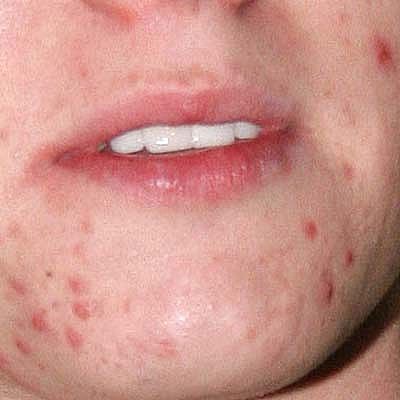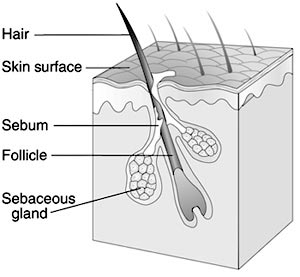

Pimple (acne) is an extremely common clinical condition in adolescence age group. The age of onset is that of puberty or a little after although many patients do not appear troubled until the age of 16 or 17 yrs. Men appear to be affected earlier and more severely than women.
Homoeopathic system of medicine has different approaches in the management of pimples. Homoeopathy treatment does not merely limit itself to controlling the acute manifestation of pimples, but instead, aims treatment on the person with altered hormonal levels thereby eradicating the whole problem. Homoeopathy has medicines not only for the acute painful pimples but also for reducing the excessive scar formation/ disfigurement caused due to acne. Some general guidelines has to be followed along with Homoeopathic medications which will be advised by the Homeopathic physician. In Homoeopathy the treatment of Acne (Pimple) is chiefly internal. Minimal use of external application is one of the principles of pimple management in Homoeopathy.
MYTHS ABOUT THE CAUSES OF ACNE
Myth # 1:
Acne is caused by a lazy life style of poor hygiene. In actuality diet or surface skin oils are not the causes of acne. In reality vigorous washing well only irritate the skin and aggravate your acne problems.
Myth # 2:
Diet: Choclates and greasy foods are often blamed but there is little evidence that foods have much effect on the development and cause of acne in most people. Dietary restriction resulting in marked weight loss reduces seborrhoea but can not be considered as routine treatment
Myth # 3:
Acne is just a teenage condition. The reality is acne affect every age group from teenagers to people beyond the age of 40.
Myth # 4:
Sex and masturbatum are cause of acne. Current research indicate no connection between sexual entercourse, masturbation and acne.
Myth # 5:
Squeezing and popping pimples is the ideal way to remove them pouching and popping your pimples actually can push germs under your skin which in turn can create additional redness, pain as well as infection. And popping pimples could sometimes leaded to permanent scarring.
Why pimples erupt?
There are several theories put forward by various researchers/ scientists regarding the causation of Acne. Single or multiple factor play a role in the formation of acne as discussed hereunder.
1. Circulating sex hormones:
The spurt is the levels of hormones during puberty correlates well with the onset of acne vulgaries. The physiological action of male hormones is to increase sebum secret ion and cause sebaceous gland hyperplasia. On the other hand oestrogens suppress sebaceous gland activity. Evidences suggests that acne results from hormonal imbalance, increasing in severity with an increase in the androgen : oestrogen ratio acne may also be aggravated by other hormones like corticosteroids and ACTH.
2. Alteration in the pattern of keratinization:
Electron microscopic and kinetic studies indicate that the primary change occurs in the pattern of keratinization of the pilary canal. Normally keratinous material is loosely arranged in sebaceous follicles but in acne, it becomes more dense. Increased production of keratinocytes and their increased adherence due to persistence of desmosomes leads to retention hyperkeratosis. These initial changes occur in the follicular infundibulum leading to the formation of microcomedones and there by initiating the process of acne.
3. Quantity and Quality of Sebum Secretion
Excess sebum secretion and sebaceous gland hypertrophy and hyperplasia usually occur in patients of acne. Sebum is comedogenic and causes inflammation when injected in skin, implicates sebum is the pathogenesis of the disease. Patients of acne show variation in the production of sebum. And the qualitative difference in free fatty and fraction sebum is also responsible for the causation of inflammation.
Factors that can make acne worse
1. Family / Genetic history
The tendency to develop acne runs in families. For example school age boys with acne have other members of their family with acne. A family history of acne is associated with an earlier occurance of acne and an increased number of acne and an increased number of relational acne lesions
2. Diet
a. Milk : A recent study based on a survey shows that there is a epidemiological association between acne and consumption of partially skimmed milk, instant breakfast drink, sherbet cheese. The researchers hypothesize that the association may be caused by hormones present in cow milk though there is evidence of an association between milk and acne, the exact cause is unclear.
b) Seafood: Seafood often contains relatively high levels of iodine. Iodine is known to make existing acne worse but there is probably not enough to cause an acne outbreak.
c) High carbohydrates/ high GI
It has also been suggested that there is a link between a diet high in refined sugars and other processed foods and acne. The theory is that rapidly digested carbohydrate food such as white bread and refined sugar produces an overload in metabolic glucose that is rapidly converted into the types of fat that can build up in sebaceous gland. But further research is necessary to establish whether a reduced consumption of high glycemic food can significantly alleviate acne though consumption of high glycemic food in any case be kept to a minimum for general health reason. Avoidance of junk food with its high fat and sugar content is also recommended.
d) Vit A and E
Studies have shown that newly diagnosed acne patients tend to have lower levels of vit A circulating in their blood stream than those that are acne free. In addition people with severe acne also tend to have lower blood levels of vit E.
3. Hormonal Activity: Such as menstrual cycles and puberty. During puberty and increase in male sex hormones called androgen cause the glands to get larger and make more Sebum
4. Stress: In stress there will increased output of hormones from the adrenal glands.
5. Drugs : Use of antibiotic, steroids
6. Exposure to certain chemical compounds
7. Occupation: Hydration of the ductal stratum corneum may induce acne is such occupations as catering patients dealing with on undoubtedly develop an acneiform oil folliculities. Particularly on their trunks and limbs
8. Cosmetics: Oil based cosmetics can worsen acne
9. Menopause association acne occurs as product of the natural anti acne ovarian hormone estradiol fails at menopause. The lack of estradiol also causes thining hair, hot flushes vaginal dryness and predisposes to osteoporosis as well as triggering acne
11. Pressure from sports, helmets or equipment, back packs, light collars or tight sport uniforms
12. Some secondary causes for acne vulgaris are secondary hyper androgenism, cushings diseases, PCOD, congenital adrenal hyperplasia.
Other conditions which mimic Pimples
1. Acne Rosacea
Rosacea, a disease of adults, is generally grouped with acne vulgaris because of similar involvement of the face, the appearance of papular or pustular lesions. It affects the flush areas of the face, manifesting with telangiectasia, erythema and papulpustular lesions, and running a chronic course.
The onset of rosacea is usually in early middle age females are commonly involved. Exacerbations occurs with excess of alcohol, heat, sun exposure vasodilators and hot food. Spontaneous remissions are known. Ocular rosacea is seen in about 50% of patients. Involvement of the eyes with blephritis, conjunctivitis, episcleritis, keratitis and iritis is also known, though its relationship with rosacea is not clear.
2. Milia
White heads may be confused with milia. The milia predominantly occur infra-orbitally, are whiter and can occur in association with acne.
3. Gram – Negative folliculitis
It is a complication of antibiotic therapy in acne vulgaris. So there will be prolonged history of antibiotic intake
4. Perioral dermatitis
In females, confusion with perioral dermatitis is possible, but in these patients the lesions itch, the skin in dry and non-inflamed lesions are lacking.
5. Warts
They present as superficial flat, skin coloured or slightly brown lesions 2-4mm in diameter, but absence of inflammation make it differs from acne.
6. Seborrheic Eczema
Patients with eczema do not have a greasy skin by a dry skin with erythematous scaly papules, particularly in the nasolabial fold and forehead. Similar lesions may be present in axilla, groin, upper trunk and scalp. There may be history or family history of asthma or hay fever.
SKIN CARE IN PEOPLE WITH PIMPLES:
1. Clean skin gently
Gently wash the face with a mild cleanser, once in the morning and once in the evening, as well as after heavy exercise. Wash the face from under the jaw to the hairline and be sure to thoroughly rinse your skin. Using strong soaps or rough scrub is not helpful and can actually make the problem worse.
If you have oily, hair, shampoo the hair regularly
2. Avoid frequent handling of the skin
Avoid rubbing and touching skin lesions. Squeezing, pinching or picking blemishes can lead to the development of scars or dark blotches.
3. Share carefully
Men who shave and who have acne should test both electric and safety razors to see which is more comfortable. When using a safety razor, make sure the blade is sharp and soften your beard thoroughly with soap and water before applying shaving cream. Shave gently and only when necessary to reduce the rise of nicking blemishes.
4. Avoid sunburn or suntan
Many of the medicines used to treat acne can make you more prone to sunburn. A sunburn that redness, the skin or suntan that darkness the skin may make blemishes less visible and make the skin feel drier. However these benefits are only temporary, and there are known risks of excessive sun exposure, such as more rapid skin aging and a risk of developing skin cancer.
5. Choose Cosmetics Carefully
All cosmetics, such as foundation, blush, eye shawdows, moisturizers, and hair – care products should be oil free and avoid cosmetic programes that advocate applying multiple layers of cream based cleanses and coverceps
6. Diet
The general diet has no effect on the amount or composition of the sebum, on the keratinization in the follicles, or on the inflammatory conversion of comedones follicles, or on the inflammatory conversion of comedones to papulopustules. It is therefore not necessary to forbet favoured foods such as chocolates, spices, nuts or meat. On the other hand, one should take account of individual observations of the patients.
7. Psychological advice
Acne patients often suffer severely from the fascial symptoms, withdrawal, feelings of anxiety and depressive moods are common reactive responses. Optimistic medical advice and psychotherapy is important to the patients guidance.
8. Avoid heavy smoking
9. Avoid exposure to oils and harsh chemicals such as petroleum
10. Exercise as a natural acne treatment
Exercise is also part of a natural acne healing process. One of the main cause of acne is attributed to stress. Exercise helps to relax the muscles and excess fat, it can also relieve stress
11. Vitamin Supplements
Vit A and B6 are essential for skin care. Zinc and Chromium are also important. Such minerals are found mostly in vegetables and fruits
12. Wash your hair often, if your hair is oily. Try to keep your hair off to your face
13. Avoid touching your face
14. Wear soft, cotton clothing or mole skin under sports equipment
3 Comments
Hello dear dr,
very informative article on pimple and its management. But do have anything in Homoeopathy to reduce the excessive scarring formed after the recovery . Kindly suggest.
Very good article I enjoy your site carry on the great blog posts
It is not clear what the baseline origin of most kinds of pimples is, but it
is generally accepted that blocked skin pores are the main offenders.
No acne remedy is going to work the same for each and
every person. But, sometimes sebum gets entrapped within the spores, due to dead skin cells,
and blocks the skin pores.